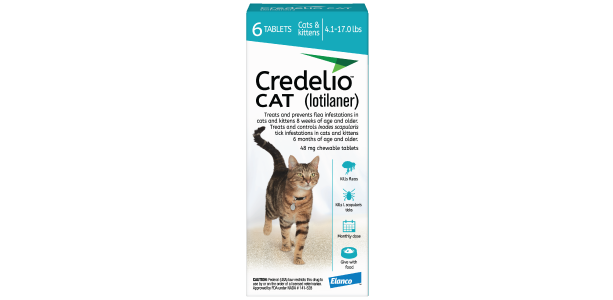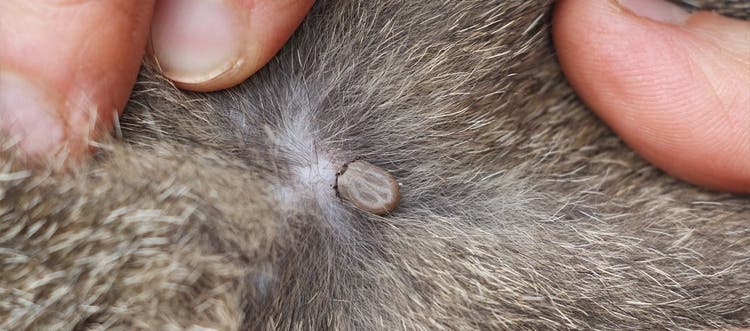How to safely remove a tick from your cat.
When you discover a tick on your cat, your first instinct may be to grab a pair of tweezers and yank it out. Resist that urge! Safely removing a tick from a cat can be tricky and requires a bit of preparation, know-how and patience.
Here’s a step-by-step guide to safely removing a tick from your cat, what to do if the tick breaks apart and signs of tick-borne diseases to watch for even after the tick has been removed.
How to Remove a Tick from Your Cat
1. Gather Your Tools
You’ll need to gather some supplies first to make the tick removal process quick and painless for your cat:
- A tick-removal tool: This tool does a much better job than tweezers, which can squeeze the tick and break it up, potentially leaving some of it behind in your cat. While tweezers aren’t recommended for removing a tick, if you don’t have a tick-removal tool on hand, use tweezers with narrow, pointed tips instead of angled or beveled tips.
- A pair of latex gloves: Ticks can carry diseases, some of which can also affect you and your family. Wear gloves to avoid direct contact with the tick.
- Antiseptic wipes or soap and water: It’s important to clean the tick bite on your pet’s skin after removing the tick.
- A small, sealed container: You’ll put the tick in this container before disposing of it to help prevent spreading disease.
- Another person, if available: If possible, find another person to help hold the cat while you remove the tick.
2. Locate the Tick on Your Cat’s Skin
Part the fur carefully around the tick, taking care to keep your cat as calm as possible. Wet the cat's hair a bit with rubbing alcohol or water so it can be patted down or parted to better see the tick. Hold the fur back with one hand so you can see it clearly. If possible, recruit a helper to hold the cat still while you work. Talk to your cat in a gentle, soothing voice, and make slow, deliberate movements.
3. Use the Tick-removal Tool to Carefully Remove the Tick, Then Dispose
Removing a tick can be tricky — you want to avoid accidentally leaving the tick’s mouthparts embedded in your cat’s skin. Follow the instructions on the tick remover, and position the tool over the tick’s body, very close to your cat’s skin. Carefully pull to bring the whole tick away without squeezing.
Avoid quick, jerking movements; you want a slow, methodical pull, especially when using tweezers. Ticks can be harder to remove than you might think, and by this point your cat may be getting more tense.
Put the tick in a sealed container, and then dispose of it immediately; consider taking a photo of the tick before throwing it away for identification purposes, just in case your pet shows signs of a tick disease and your vet needs to identify what kind of tick was on your cat.
Good to know: You should never try to burn off a tick or “suffocate” it with a layer of petroleum jelly, as these methods could injure your cat and typically won’t bother the tick.
4. Clean the Tick Bite
Gently wipe the affected area on your pet with soap and lukewarm water or an antiseptic designed for pets.
5. Clean Up and Treat Your Cat
Dispose of the gloves and wash your hands thoroughly. Clean your tick-removal tool with a disinfectant and store it safely in case you need it again.
And don’t forget to give your cat a treat along with lots of praise and cuddles for being such a good patient!
6. Know When to Seek Outside Help
If your cat gets distressed, the tick is particularly deep in the cat's ear canal or you’re struggling to remove parts of the tick, consider seeking advice from your vet.
Help! The Tick’s Head Is Stuck in My Cat
Sometimes, a tick might break in half during removal, leaving its mouthparts still embedded in the skin of your cat. This is not uncommon. If there is enough of the tick still visible that can be grasped by the tick removal tool, go ahead and try to pull the remaining part out. If this isn’t the case, or you can’t get a good grasp, it’s best to leave the area alone and let the body work the head out on its own, just as a splinter does in human skin.
If you leave the mouthpart, wash the area with warm soapy water and keep an eye on it to make sure it’s healing and not becoming red or inflamed. Continual prodding of the area may not only be painful for the cat, but it could push the mouthparts further into the skin, causing irritation and potential infection.
Watch for Signs of Illness After Tick Removal
Even if the tick is gone, your cat might not be in the clear because ticks can transmit a number of diseases to cats. In the days and weeks after removing the tick, look for signs of lethargy, jaundice (yellowing of the ears and white parts of the eyes), lack of appetite or heavy breathing. Alert your vet if you observe any of these symptoms.
How to Avoid Ticks on Your Cat
If your cat spends lots of time outdoors — especially in areas known for ticks — it’s advisable to use a product to help protect your cat against them, such as a spot-on treatment or a tick collar. Make sure to use a product specifically designed for cats, as some dog products can be extremely dangerous for felines. Utilizing tick protection products and regularly checking your cat for these parasites can go a long way in limiting the discomfort ticks could potentially cause your cat.

Seresto® Flea & Tick Collar for Cats
An easy-to-use, odorless, non-greasy collar that kills and repels fleas and ticks for 8 continuous months.

Credelio® CAT (lotilaner)
Protect your feline friend with Credelio Cat, the first and only flea and tick chewable for cats.

Advantage® Treatment Spray for Cats
An on-pet treatment spray that kills and repels fleas, ticks and lice.
Related Articles
Credelio® CAT (lotilaner)
Indications:
Credelio CAT kills adult fleas and is indicated for the treatment and prevention of flea infestations for one month in cats and kittens 8 weeks of age and older and weighing 2 pounds or greater.
Credelio CAT is also indicated for treatment and control of black-legged tick infestations for one month in cats and kittens 6 months of age and older and weighing 2 pounds or greater.
Important Safety Information:
Lotilaner is a member of the isoxazoline class of drugs. This class has been associated with neurologic adverse reactions including tremors, incoordination, and seizures. Neurologic adverse reactions have been reported in cats receiving isoxazoline class drugs, even in cats without a history of neurologic disorders. Use with caution in cats with a history of neurologic disorders. The safety of Credelio CAT has not been established in breeding, pregnant and lactating cats. The effectiveness of Credelio CAT against black-legged ticks in kittens less than 6 months of age has not been evaluated. The most frequently reported adverse reactions are weight loss, rapid breathing and vomiting. For complete safety information, please see Credelio CAT product label or ask your veterinarian.





